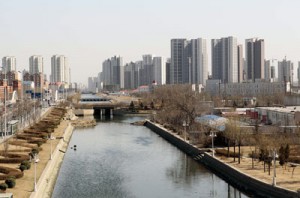Source: World Bank, November 9, 2011.
 Winter is approaching and it’s time to turn on the heat. Shen Tianxiang, a resident of Tianjin, China, is content that he will pay less for heating than before, since he now lives in an energy-efficient home.
Winter is approaching and it’s time to turn on the heat. Shen Tianxiang, a resident of Tianjin, China, is content that he will pay less for heating than before, since he now lives in an energy-efficient home.
Heating is vital to survive winter in northern China – where temperatures can plunge to -30 degrees Celsius. But most of the heating systems there are coal-fired, centralized, inefficient and have poor emission controls. Buildings also lack proper insulation.
To make things worse, there’s little incentive for people to cut their high energy use – the bills most people pay are dictated by the size of their apartment, not by how much energy they use.
On average, residential buildings in China use twice as much energy to heat as places in Europe or the United States where the temperature can be just as cold.
A project supported by the World Bank and the Global Environment Facility (GEF) is helping bring change – to modernize heating systems and speed up energy efficiency in China’s urban homes.
Saving both energy and money
Shen Tianxiang lives in Tianjin’s Huasha Classic Community, a residential complex that is part of the Heat Reform and Building Energy Efficiency Project. These buildings demonstrate energy efficiency gains and cost savings in residential space heating.
The project, launched in 2005, aims to
- Improve enforcement of energy efficiency standards for buildings , as well as design and use of insulation and other energy-saving measures;
- Implement heat metering, cost-based pricing and consumption-based billing;
- Modernize heat supply systems so that residents can control when the heat is on.
“Since we adopted heat metering, I can save more than 2,000 yuan ($300) a year,” Shen says. “With insulated external walls, I only need to turn on one of the eight radiators around my apartment. In the past, when we didn’t have the control valve, we had to open the windows when it got too warm in the room. Now we save both energy and money.”
“In Huasha Classic community alone, last winter, about 60 percent of the residents paid lower heating fees than before the adoption of heat metering and other energy-saving measures. This shows that residents can get some real benefits from energy-efficient buildings,” says Tang Xiao, a project coordinator with the Tianjin Housing and Urban-Rural Development Commission, which manages the project implementation in Tianjin.
The project has also motivated developers by covering a portion of the incremental costs associated with their energy efficiency innovations. Wang Jian, Vice President and Chief Engineer of Tianjin Huasha Construction & Development Company, says his company has gained good experience that can be used in future work.
“Participating in this project has also strengthened our company’s brand,” he says.
The benefits go beyond energy savings, he says. “This project also inspired us to explore resource-saving measures in a broader scope. For example, we built a water recycling system in this complex.”
Besides, the local government conducts wide-ranging public education campaigns on energy efficiency in residential buildings, which are partly supported by the project. Brochures on heat metering are handed to each household when they move in to a newly-built apartment building.
From Tianjin to other cities
Tianjin has been a pilot in heat reform and is setting a model for other cities in China. By 2015, it plans to set up controllable heating systems and consumption-based billing in 35% of the existing buildings and 100% of new buildings.
Other cities are making similar efforts. The project also helped Urumqi, in Northwestern China’s Xinjiang Province, to develop one of the first green building developments and supported several other cities to develop consumption-based billing policies.
“China has made strong efforts in the past few years in improving energy efficiency in buildings. First, it has promoted advanced energy efficiency standards for buildings; second, it has also looked into how to enforce those standards, so that buildings that are designed are in fact built according to those standards,” says Gailius Draugelis, a senior energy specialist at the World Bank.
From residential buildings to overall low carbon cities
China’s building boom is happening not only in the North, where much attention has been paid to improve energy efficiency standards because of the region’s heavy use of energy for heating, but also in the South, where air conditioning can easily be running for six months a year and also requires smarter energy use.
Rapid urbanization also drives construction of office buildings and other facilities, which have significant energy needs, too.
Experts say that energy-efficient buildings are one of the most cost-effective approaches to reduce greenhouse gas emissions and help save resources.
“We are prepared to expand our efforts, to look not only into energy efficiency in residential buildings,” says Draugelis, “but also how we can integrate these principles into our quest for low-carbon cities in China.”